Sustainable Living on the Move: Lida Group’s Prefab Mobile House Features Eco-Friendly, Low-Cost Sandwich Panel Walls
2025-Sep-24 14:08:46
By Admin
1. Introduction
In an era marked by growing environmental concerns, rapid urbanization, and a rising demand for flexible living solutions, the concept of sustainable living has transcended traditional boundaries. No longer confined to fixed, brick-and-mortar homes, sustainable living now encompasses mobility—allowing individuals and communities to adapt to changing circumstances while minimizing their ecological footprint. This shift has given rise to a new wave of innovation in the construction industry, with prefabricated (prefab) mobile houses emerging as a promising alternative to conventional housing. Among the pioneers in this field is Lida Group, a global leader in prefabricated building solutions, whose prefab mobile houses stand out for their innovative use of eco-friendly, low-cost sandwich panel walls.
The global housing crisis, exacerbated by factors such as population growth, resource scarcity, and climate change, has highlighted the need for housing solutions that are not only affordable but also environmentally responsible. Conventional construction methods are often resource-intensive, generating significant amounts of waste, consuming large quantities of energy, and contributing to greenhouse gas emissions. In contrast, prefab construction offers a more sustainable approach, with off-site manufacturing reducing waste, optimizing resource use, and minimizing on-site disruption. Mobile prefab houses take this a step further by providing flexibility—they can be easily transported, installed, and relocated, making them ideal for a range of applications, from emergency housing and temporary work sites to eco-tourism accommodations and affordable housing projects.
Lida Group has long been at the forefront of prefab construction innovation, and their mobile house range is a testament to their commitment to sustainability and affordability. At the heart of these houses is the sandwich panel wall system, a key feature that combines eco-friendliness and low cost without compromising on quality, durability, or comfort. This article will delve into the world of Lida Group’s prefab mobile houses, exploring the unique properties of their sandwich panel walls, the overall design and functionality of the houses, their applications across different sectors, and their contribution to a more sustainable future.
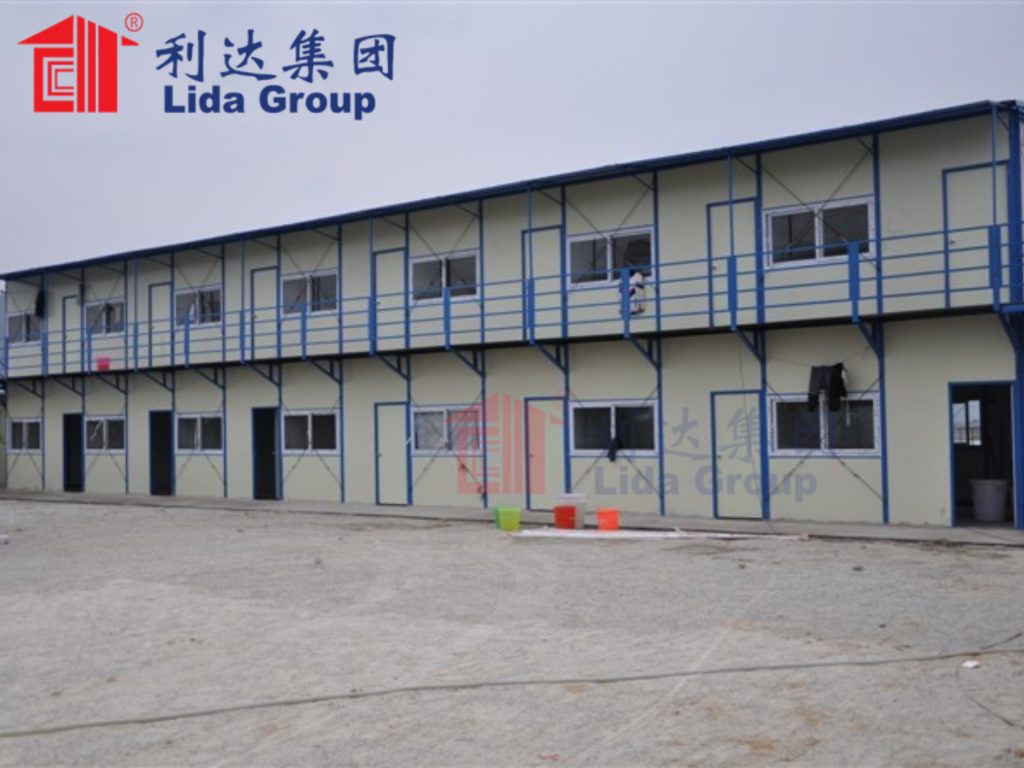
2. Understanding Prefab Mobile Houses and the Role of Sandwich Panels
2.1 What are Prefab Mobile Houses?
Prefab mobile houses, also known as modular mobile homes, are constructed in a factory setting, with components (or modules) manufactured off-site before being transported to the final location for assembly. Unlike traditional mobile homes, which are often associated with low quality and limited design options, modern prefab mobile houses leverage advanced manufacturing techniques and high-quality materials to deliver durable, comfortable, and customizable living spaces.
The key advantage of prefab mobile houses lies in their efficiency. Factory manufacturing allows for precise control over the production process, reducing errors and ensuring consistent quality. It also minimizes waste, as materials can be measured and cut with greater accuracy, and excess materials can be recycled or reused within the factory. Additionally, prefab mobile houses can be constructed much faster than conventional homes—often in a matter of weeks rather than months—making them an ideal solution for urgent housing needs, such as after natural disasters or for rapidly expanding communities.
Mobility is another defining feature of these houses. Equipped with a sturdy chassis or designed to be easily transported via trucks, prefab mobile houses can be relocated to different sites as needed. This flexibility is particularly valuable in industries such as construction, mining, and oil and gas, where workers often need to move to remote locations for short-term projects. It also appeals to individuals seeking a nomadic lifestyle or those who want the option to change their living environment without the hassle of selling a traditional home.
2.2 The Importance of Wall Systems in Prefab Mobile Houses
Walls are a critical component of any building, and in prefab mobile houses, they play an even more significant role. They not only provide structural support but also contribute to the house’s insulation, soundproofing, fire resistance, and overall aesthetic appeal. Given the mobility of these houses, walls must also be lightweight yet strong enough to withstand the rigors of transportation and installation.
Traditional wall systems, such as brick and mortar or wooden framing with drywall, are often unsuitable for prefab mobile houses. Brick and mortar are heavy, making transportation difficult and increasing fuel consumption during transit. Wooden framing, while lighter, may be prone to rot, mold, or insect infestations, especially in humid or harsh environments. Additionally, both traditional wall systems require significant on-site labor for installation, negating some of the efficiency benefits of prefab construction.
This is where sandwich panel walls come in. Sandwich panels are composite materials consisting of two outer layers (facings) and a core material sandwiched between them. The facings are typically made of materials such as steel, aluminum, or fiber-reinforced plastic (FRP), which provide strength and durability. The core can be made of a variety of materials, including foam (such as polyurethane foam, polystyrene foam, or rock wool), which offers excellent insulation properties.
Sandwich panel walls address many of the challenges associated with traditional wall systems in prefab mobile houses. They are lightweight, reducing the overall weight of the house and making transportation easier and more cost-effective. They are also strong and durable, able to withstand transportation vibrations and harsh weather conditions. Furthermore, their modular design allows for quick and easy assembly, as panels can be simply bolted or bonded together on-site. Most importantly, sandwich panels offer superior insulation, which helps to reduce energy consumption for heating and cooling, making the house more eco-friendly and cost-effective to operate.
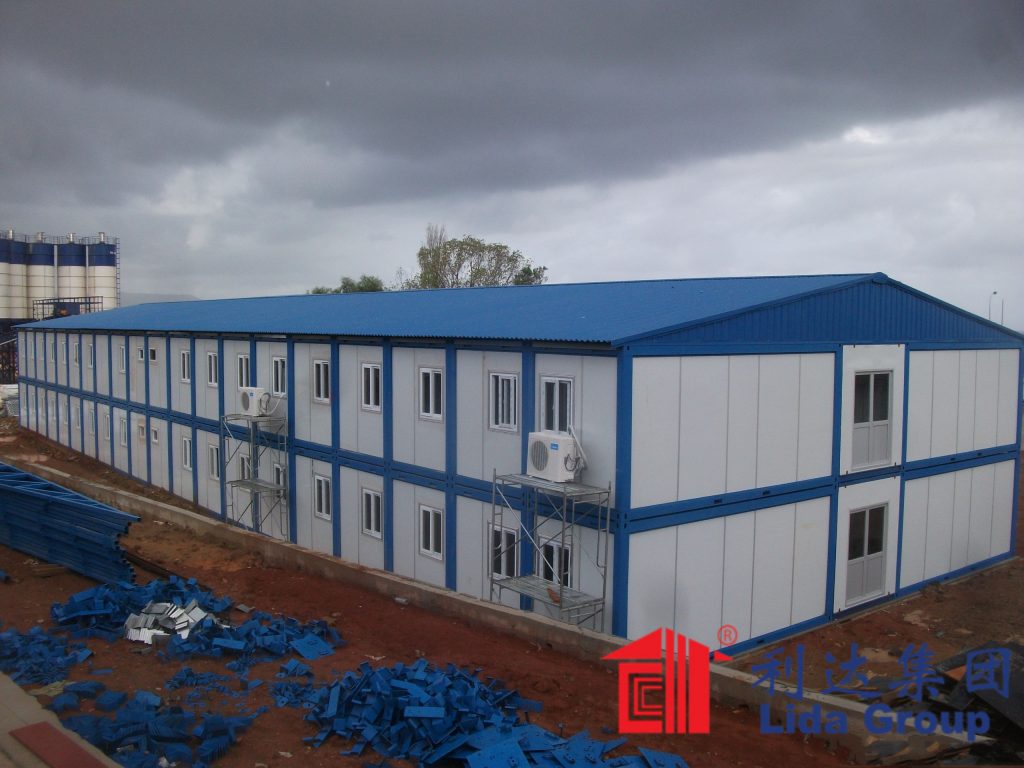
3. Lida Group’s Eco-Friendly Sandwich Panel Walls: Materials and Manufacturing
3.1 Sustainable Materials Selection
Lida Group places a strong emphasis on sustainability in every aspect of their prefab mobile house production, starting with the materials used in their sandwich panel walls. The company has invested significant resources in researching and sourcing eco-friendly materials that minimize environmental impact while ensuring high performance.
The outer facings of Lida Group’s sandwich panels are primarily made of galvanized steel or aluminum. Galvanized steel is chosen for its durability, corrosion resistance, and recyclability. The galvanization process involves coating steel with a layer of zinc, which protects the steel from rust and extends its lifespan. At the end of the panel’s life, the steel can be easily recycled, reducing the need for virgin steel production and the associated energy consumption and greenhouse gas emissions. Aluminum is another sustainable option, as it is lightweight, strong, and highly recyclable. Recycling aluminum requires only a fraction of the energy needed to produce virgin aluminum, making it a low-carbon material.
The core material of Lida Group’s sandwich panels is a key factor in their eco-friendliness. The company offers a range of core options, all of which are chosen for their environmental performance. One of the most popular core materials is polyurethane foam (PU foam), which is known for its excellent insulation properties. Lida Group uses high-quality PU foam that is free from ozone-depleting substances (ODS) and has a low global warming potential (GWP). The foam is also highly durable, ensuring long-term insulation performance and reducing the need for frequent replacements.
Another eco-friendly core material used by Lida Group is rock wool (also known as mineral wool). Rock wool is made from natural minerals, such as basalt or diabase, which are melted and spun into fibers. It is a non-combustible material, offering excellent fire resistance, and it is also sound absorbent, improving the acoustic performance of the house. Rock wool is 100% recyclable and does not release harmful chemicals into the environment, making it a sustainable choice for eco-conscious consumers.
In addition to the facings and core, Lida Group also pays attention to the adhesives and sealants used in the sandwich panels. The company uses low-VOC (volatile organic compound) adhesives and sealants, which emit fewer harmful chemicals into the air, improving indoor air quality. This is particularly important for mobile houses, where living spaces are often compact, and good indoor air quality is essential for the health and well-being of occupants.
3.2 Environmentally Friendly Manufacturing Processes
Lida Group’s commitment to sustainability extends beyond material selection to its manufacturing processes. The company operates state-of-the-art factories that are designed to minimize energy consumption, reduce waste, and lower greenhouse gas emissions.
One of the key features of Lida Group’s manufacturing process is the use of automated production lines. Automated machines ensure precise cutting, shaping, and assembly of the sandwich panels, reducing material waste and improving production efficiency. For example, the cutting of the core materials and facings is done using computer-controlled machines that can optimize the use of materials, minimizing offcuts. Any excess materials generated during production are collected and recycled or reused within the factory, further reducing waste.
Energy efficiency is another priority in Lida Group’s factories. The company has invested in energy-efficient equipment, such as high-efficiency motors, LED lighting, and heat recovery systems. Heat recovery systems capture waste heat from manufacturing processes, such as the foam insulation production, and reuse it to heat the factory or for other industrial purposes. This reduces the need for fossil fuel-based heating, lowering energy consumption and greenhouse gas emissions.
Lida Group also uses renewable energy sources to power its factories wherever possible. In some locations, the company has installed solar panels on the roofs of its factories, generating clean, renewable electricity to supplement the grid supply. This not only reduces the company’s carbon footprint but also helps to stabilize energy costs, which in turn contributes to the low-cost nature of the sandwich panel walls.
Water conservation is another aspect of Lida Group’s sustainable manufacturing practices. The company has implemented water-saving measures in its factories, such as the use of closed-loop water systems for cooling and cleaning. Closed-loop systems recycle water, reducing the amount of freshwater consumed and minimizing wastewater discharge. Any wastewater that is generated is treated before being released, ensuring that it meets environmental standards and does not harm local ecosystems.
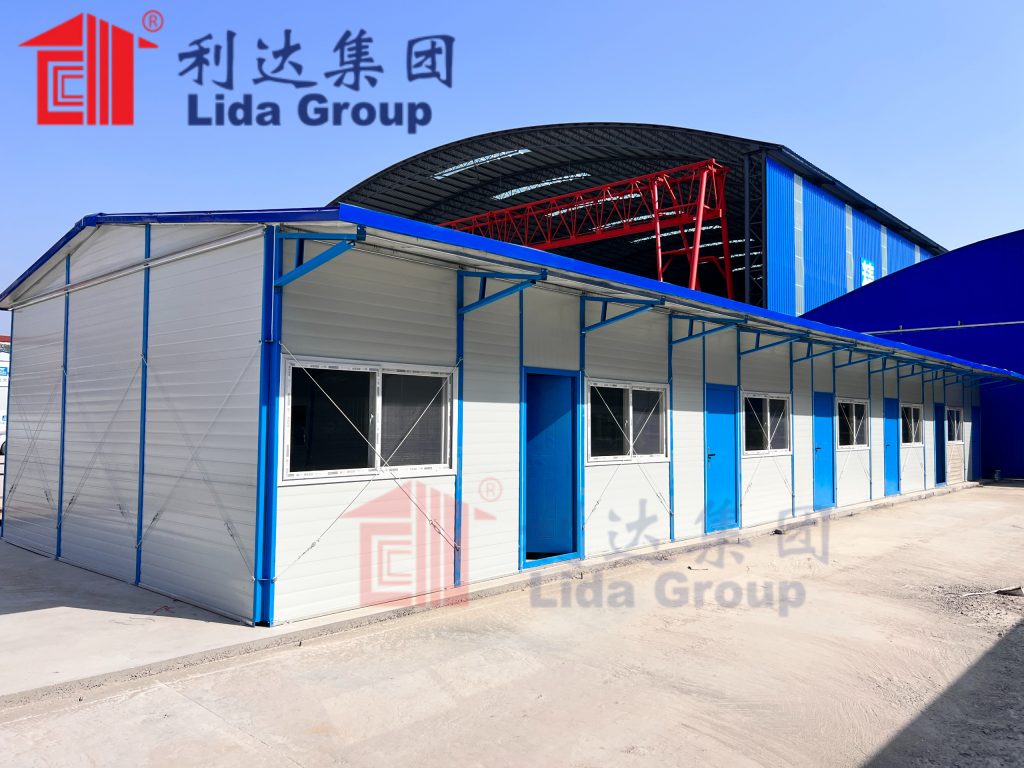
4. Low-Cost Advantage of Lida Group’s Sandwich Panel Walls
4.1 Cost Savings in Material Sourcing and Production
One of the most compelling features of Lida Group’s prefab mobile houses is their affordability, and this is largely attributed to the low-cost nature of their sandwich panel walls. Lida Group has implemented a range of strategies to minimize the cost of the sandwich panels without compromising on quality or sustainability.
In terms of material sourcing, Lida Group has established long-term partnerships with leading suppliers of steel, aluminum, foam, and other raw materials. These partnerships allow the company to negotiate favorable pricing, ensuring a stable supply of high-quality materials at competitive rates. The company also leverages its global purchasing power to source materials from regions where they are abundant and cost-effective, further reducing material costs.
The modular design of the sandwich panels also contributes to cost savings. The panels are manufactured in standard sizes, which allows for mass production. Mass production reduces the cost per unit, as fixed costs (such as equipment and labor) are spread over a larger number of units. Additionally, standardization makes it easier to manage inventory, as the company can produce panels in bulk and store them until needed, reducing the risk of stockouts and minimizing the cost of rush orders.
The automated manufacturing process used by Lida Group also helps to lower production costs. Automated machines are more efficient than manual labor, reducing the time required to produce each panel and minimizing labor costs. They also reduce the risk of errors, which can lead to costly rework or material waste. By streamlining the production process, Lida Group is able to produce sandwich panels at a lower cost than many of its competitors.
4.2 Cost Savings in Transportation and Installation
The lightweight nature of Lida Group’s sandwich panel walls provides significant cost savings in transportation. Compared to traditional wall materials, such as brick and mortar, sandwich panels are much lighter, which means that more panels can be transported in a single truckload. This reduces the number of trips required to transport the materials to the construction site, lowering fuel costs and transportation fees.
For example, a truckload of brick and mortar may only be able to carry a limited number of wall components due to their weight, whereas the same truck can carry a much larger quantity of sandwich panels. This not only reduces transportation costs but also minimizes the carbon footprint associated with transportation, aligning with the company’s sustainability goals.
The ease of installation of sandwich panel walls also contributes to cost savings. The panels are designed to be quickly and easily assembled on-site, requiring minimal labor and specialized equipment. Unlike traditional wall systems, which require skilled masons or carpenters to build, sandwich panels can be installed by a relatively small team of workers with basic training. This reduces labor costs and shortens the installation time, allowing the prefab mobile house to be ready for use in a shorter period.
Furthermore, the modular design of the panels means that they can be easily cut and adjusted to fit the specific dimensions of the house, reducing the need for custom-made components. Custom components are often more expensive and time-consuming to produce, so the ability to use standard panels with minimal adjustments helps to keep costs down.
4.3 Long-Term Cost Savings for Occupants
The cost advantages of Lida Group’s sandwich panel walls are not limited to the initial construction phase; they also translate into long-term cost savings for the occupants of the prefab mobile house.
One of the main long-term cost savings comes from the superior insulation properties of the sandwich panels. The core materials, such as PU foam or rock wool, provide excellent thermal insulation, reducing the amount of energy needed to heat or cool the house. In cold climates, the insulation helps to retain heat inside the house, lowering heating costs. In hot climates, it keeps the house cool, reducing the need for air conditioning and lowering electricity bills.
Studies have shown that buildings with good insulation can reduce energy consumption for heating and cooling by up to 50% compared to buildings with poor insulation. For occupants of Lida Group’s prefab mobile houses, this translates into significant savings on energy bills over the lifetime of the house. For example, a family living in a prefab mobile house with sandwich panel walls may save hundreds or even thousands of dollars each year on heating and cooling costs compared to a family living in a traditional mobile home with less efficient insulation.
The durability of the sandwich panel walls also contributes to long-term cost savings. The outer facings of the panels are resistant to corrosion, rot, and insect infestations, ensuring that the walls remain in good condition for many years. This reduces the need for frequent repairs or replacements, which can be costly. For example, wooden walls may require regular painting or treatment to prevent rot, while brick walls may develop cracks over time that need to be repaired. In contrast, sandwich panel walls require minimal maintenance, saving occupants both time and money.
Additionally, the fire resistance of some core materials, such as rock wool, can help to reduce insurance costs. Insurance companies often offer lower premiums for buildings that are more fire-resistant, as they are less likely to suffer severe damage in the event of a fire. This is an added benefit for occupants, further enhancing the cost-effectiveness of Lida Group’s prefab mobile houses.
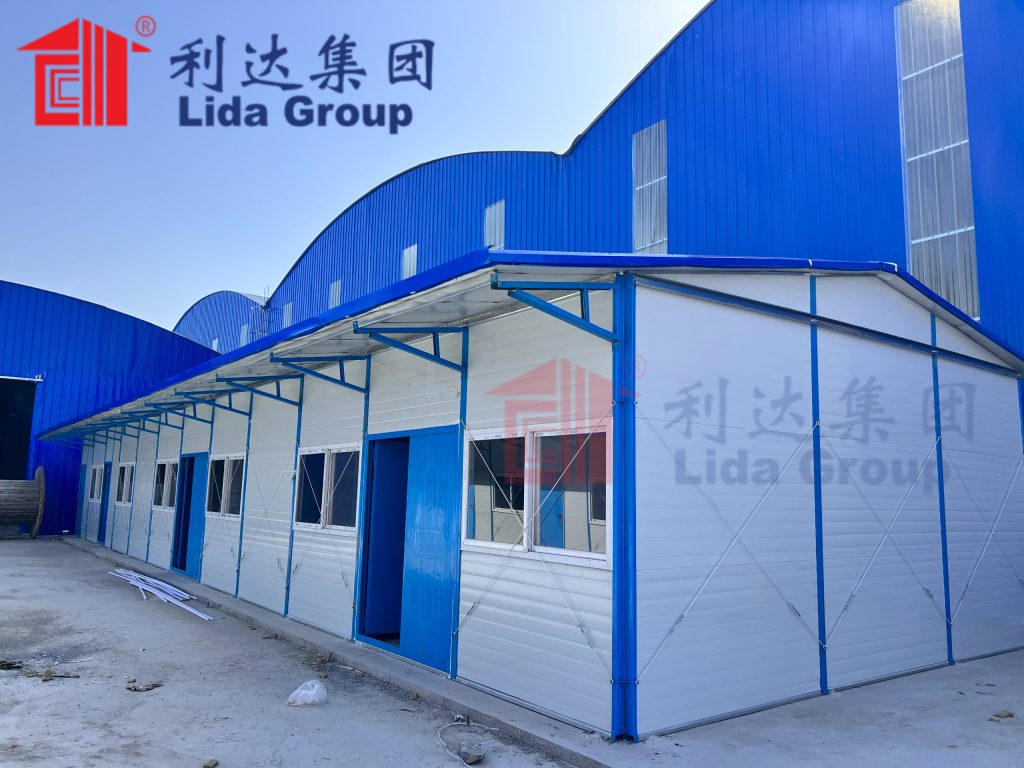
5. Design and Functionality of Lida Group’s Prefab Mobile Houses
5.1 Customization Options to Meet Diverse Needs
While Lida Group’s prefab mobile houses are based on a modular design, the company recognizes that every customer has unique needs and preferences. As a result, the houses offer a high degree of customization, allowing customers to tailor the design to their specific requirements.
The sandwich panel walls play a key role in this customization. The panels are available in a range of colors and finishes, allowing customers to choose an exterior look that matches their personal style or the surrounding environment. For example, customers can opt for a sleek, modern finish with a metallic sheen or a more traditional look with a wood-grain texture. The panels can also be painted or coated with additional materials to further enhance their appearance or provide additional protection against the elements.
In terms of interior design, the sandwich panel walls can be easily integrated with a variety of interior finishes, such as drywall, wood paneling, or tile. This allows customers to create a living space that feels warm and inviting, despite the house’s prefabricated nature. The modular design of the house also allows for flexible floor plans. Customers can choose from a range of standard floor plans, or they can work with Lida Group’s design team to create a custom floor plan that meets their specific needs. For example, a customer may need an extra bedroom for a growing family, a home office for remote work, or a large living area for entertaining guests. The design team can adjust the size and layout of the modules to accommodate these requests.
The size of the prefab mobile house is also customizable. Lida Group offers houses in a range of sizes, from small, single-module units that are ideal for individuals or couples to large, multi-module units that can accommodate families or even small communities. The modules can be connected in different configurations, allowing for endless possibilities in terms of size and layout.
5.2 Comfort and Livability Features
Lida Group’s prefab mobile houses are designed with comfort and livability in mind. The sandwich panel walls, with their excellent insulation properties, help to create a comfortable indoor environment year-round. In addition to thermal insulation, the panels also provide good sound insulation, reducing the transmission of noise from outside the house to the interior. This is particularly important for mobile houses that may be located in busy or noisy areas, such as construction sites or near highways. The sound insulation helps to create a quiet, peaceful living space, improving the quality of life for occupants.
The houses are also equipped with high-quality windows and doors that further enhance comfort and energy efficiency. The windows are made of double-glazed glass, which provides additional insulation and helps to reduce heat loss in winter and heat gain in summer. They also allow plenty of natural light to enter the house, creating a bright and airy living space. The doors are designed to be durable and secure, with good insulation properties to prevent drafts.
Lida Group pays attention to the ventilation system in the prefab mobile houses. Proper ventilation is essential for maintaining good indoor air quality and preventing the buildup of moisture, which can lead to mold and mildew. The houses are equipped with mechanical ventilation systems that ensure a constant supply of fresh air, while also removing stale air and moisture. Some models also feature energy recovery ventilation (ERV) systems, which recover heat from the outgoing air and use it to preheat the incoming air, improving energy efficiency.
The interior of the houses is designed to be functional and comfortable. The rooms are spacious, with high ceilings that create a sense of openness. The kitchen and bathroom are equipped with modern, high-quality fixtures and appliances, making daily tasks easier and more enjoyable. The living area and bedrooms are designed to be flexible, allowing occupants to arrange furniture and decor to suit their personal style.
5.3 Durability and Safety
Durability and safety are top priorities for Lida Group, and these aspects are deeply integrated into the design and construction of their prefab mobile houses—with the sandwich panel walls playing a central role.
Starting with durability, the sandwich panel walls are engineered to withstand a wide range of environmental conditions. The outer galvanized steel or aluminum facings provide robust protection against corrosion, even in humid coastal areas or regions with high levels of industrial pollution. The zinc coating on galvanized steel acts as a sacrificial layer, preventing the underlying steel from rusting, while aluminum naturally forms a protective oxide layer that resists degradation. This durability ensures that the walls maintain their structural integrity and appearance for decades, even with minimal maintenance.
The core materials also contribute to the overall durability of the walls. Polyurethane foam cores are resistant to water absorption, mold growth, and pest infestations, which can weaken traditional wall systems over time. Rock wool cores, being inorganic, are similarly immune to mold and pests, and their non-combustible nature adds an extra layer of durability in fire-prone areas. Additionally, the bonding between the facings and the core is designed to be strong and long-lasting, preventing delamination—a common issue in low-quality sandwich panels—even under extreme temperature fluctuations or vibration during transportation.
In terms of structural safety, Lida Group’s prefab mobile houses undergo rigorous testing to meet or exceed international building codes and standards. The sandwich panel walls are designed to provide sufficient load-bearing capacity, supporting the weight of the roof, floors, and any additional fixtures. The panels are also tested for resistance to wind, snow, and seismic activity, ensuring that the house can withstand natural disasters in various geographic locations. For example, in areas prone to strong winds, the panels are reinforced with additional fasteners to prevent them from being dislodged, while in seismic zones, the modular design of the house allows for flexibility, reducing the risk of structural damage during an earthquake.
Fire safety is another critical aspect of Lida Group’s design. As mentioned earlier, rock wool core panels are non-combustible and have a high fire resistance rating, meaning they can withstand high temperatures for an extended period without burning or releasing toxic gases. Even panels with polyurethane foam cores are treated with flame retardants to meet fire safety standards, slowing the spread of fire and giving occupants more time to evacuate in case of an emergency. The company also ensures that all electrical wiring and fixtures used in the houses are fire-rated, further minimizing the risk of fire hazards.
To enhance occupant safety, Lida Group’s prefab mobile houses are equipped with smoke detectors, carbon monoxide detectors, and fire extinguishers as standard features. The windows and doors are designed to be easily opened from the inside, providing clear escape routes in case of an emergency. Additionally, the floors and stairs are made of slip-resistant materials, reducing the risk of falls, especially in wet conditions.
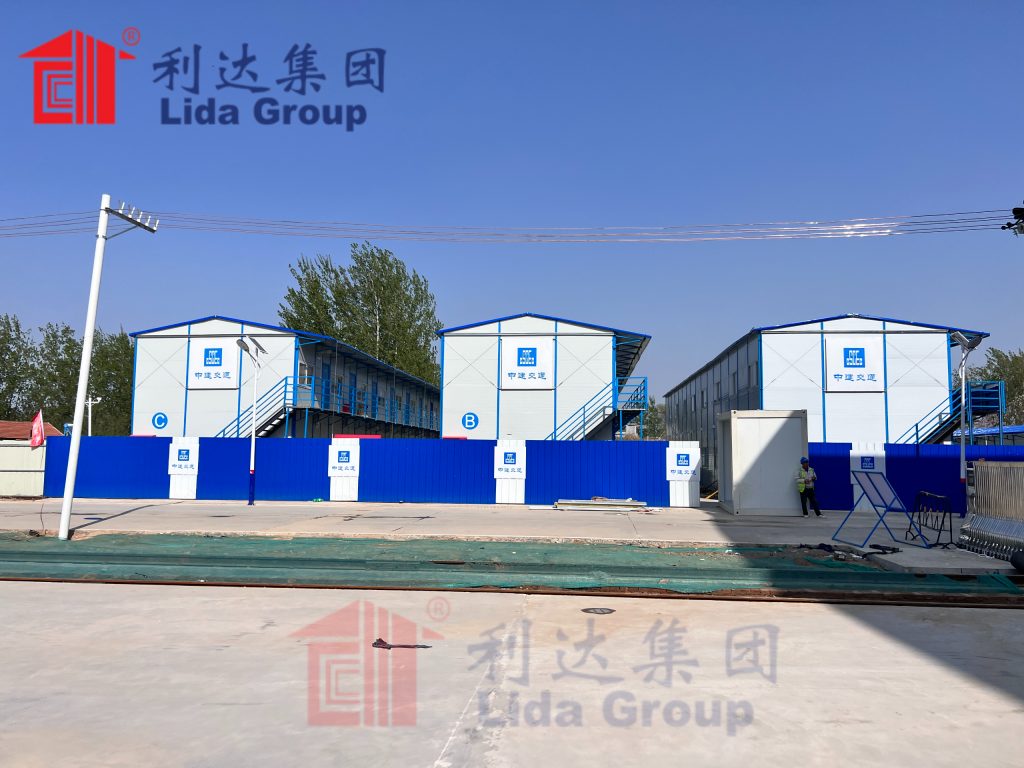
6. Applications of Lida Group’s Prefab Mobile Houses
Lida Group’s prefab mobile houses, with their eco-friendly, low-cost, and durable sandwich panel walls, are versatile and suitable for a wide range of applications across different sectors. Their flexibility, quick installation time, and customizable design make them an ideal solution for various housing needs, from temporary to semi-permanent use.
6.1 Emergency Housing
Natural disasters such as earthquakes, hurricanes, floods, and wildfires often leave thousands of people homeless, creating an urgent need for safe and temporary shelter. Lida Group’s prefab mobile houses are well-suited for emergency housing due to their rapid deployment capability. Since the houses are prefabricated in factories, they can be produced in large quantities quickly and transported to disaster-stricken areas within days.
The sandwich panel walls’ lightweight nature makes transportation to remote or hard-to-reach areas easier, even when infrastructure is damaged. Once on-site, the houses can be assembled in a matter of hours or days, providing immediate shelter for displaced families. The excellent insulation of the sandwich panels ensures that the houses remain warm in cold weather and cool in hot weather, protecting occupants from harsh environmental conditions. Additionally, the houses are equipped with basic amenities such as beds, a small kitchenette, and a bathroom, ensuring that occupants have a comfortable and dignified living space while they rebuild their lives.
Lida Group has a proven track record in providing emergency housing. For example, after a major earthquake in a Southeast Asian country in 2023, the company supplied over 500 prefab mobile houses to the affected region, helping to house more than 2,000 people. The houses were praised for their durability, comfort, and quick installation, which played a crucial role in the disaster recovery effort.
6.2 Temporary Workforce Housing
Industries such as construction, mining, oil and gas, and renewable energy often require workers to be stationed in remote locations for short to medium-term projects. Providing suitable housing for these workers can be a challenge, especially in areas where traditional housing is scarce or non-existent. Lida Group’s prefab mobile houses offer an ideal solution for temporary workforce housing.
The houses can be customized to meet the specific needs of different industries. For construction workers, the houses can be designed with multiple bedrooms, a communal living area, and a large kitchen to accommodate a team of workers. For oil and gas workers, who may be stationed in harsh environments such as deserts or arctic regions, the houses can be equipped with enhanced insulation, heating, and cooling systems to ensure comfort. The mobility of the houses also means that they can be relocated to new project sites once the current project is completed, reducing the need for building new housing each time.
The low cost of the sandwich panel walls makes the houses an affordable option for companies, helping to reduce their overall project costs. Additionally, the houses’ durability ensures that they can withstand the wear and tear of multiple relocations and long-term use, providing good value for money. Many leading companies in the construction and mining sectors have partnered with Lida Group to provide housing for their remote workforce, citing the houses’ quality, affordability, and flexibility as key reasons for their choice.
6.3 Eco-Tourism Accommodations
The global eco-tourism industry is growing rapidly, with more and more travelers seeking sustainable and environmentally friendly travel options. Eco-tourism accommodations, such as lodges, cabins, and campsites, need to be designed to minimize their environmental impact while providing a comfortable and authentic experience for guests. Lida Group’s prefab mobile houses are an excellent fit for this sector.
The eco-friendly features of the sandwich panel walls, such as the use of recyclable materials and low-VOC adhesives, align with the sustainability goals of eco-tourism. The houses’ excellent insulation reduces energy consumption, allowing them to be powered by renewable energy sources such as solar panels or wind turbines—further enhancing their eco-friendly credentials. Additionally, the mobile nature of the houses means that they can be installed without causing significant damage to the natural environment. Unlike traditional construction, which requires clearing land, digging foundations, and disrupting local ecosystems, prefab mobile houses can be placed on temporary foundations, leaving the surrounding environment largely intact.
Lida Group’s prefab mobile houses can be customized to match the aesthetic of the eco-tourism destination. For example, in a forested area, the houses can be finished with wood-grain paneling to blend in with the natural surroundings, while in a coastal area, they can be painted in light, beachy colors. The houses can also be equipped with eco-friendly amenities such as composting toilets, rainwater harvesting systems, and energy-efficient appliances, further appealing to eco-conscious travelers.
Several eco-tourism resorts around the world have already adopted Lida Group’s prefab mobile houses. One such resort in Costa Rica uses the houses as guest cabins, offering visitors a chance to stay in a sustainable, comfortable accommodation while exploring the country’s rich biodiversity. The resort has reported high guest satisfaction rates, with many visitors praising the cabins’ eco-friendly design and connection to nature.
6.4 Affordable Housing
The global affordable housing crisis is one of the most pressing social issues of our time, with millions of people unable to access safe, decent, and affordable housing. Lida Group’s prefab mobile houses offer a viable solution to this crisis, providing low-cost housing options that do not compromise on quality or comfort.
The low-cost nature of the sandwich panel walls, combined with the efficient manufacturing and installation processes, means that Lida Group’s prefab mobile houses are significantly more affordable than traditional homes. This makes them accessible to low-income families, young professionals, and individuals who may not be able to afford a conventional house. The houses can be sold at a fraction of the cost of a traditional home, or they can be rented at affordable rates, providing a flexible housing option for those with limited financial resources.
In many developing countries, where urbanization is happening at a rapid pace, the demand for affordable housing is particularly high. Lida Group has partnered with local governments and non-governmental organizations (NGOs) in these countries to provide prefab mobile houses as part of affordable housing projects. For example, in a slum upgrading project in India, the company supplied 1,000 prefab mobile houses to replace informal settlements, providing residents with safe, clean, and affordable housing. The houses were equipped with basic amenities such as running water, electricity, and a bathroom, significantly improving the quality of life for the residents.
Even in developed countries, Lida Group’s prefab mobile houses are being used to address affordable housing needs. In some European countries, the houses are used as temporary housing for homeless individuals or as affordable rental units for low-income families. The houses’ mobility means that they can be placed in areas where housing demand is high, such as near city centers or public transportation hubs, making it easier for residents to access jobs, education, and other essential services.
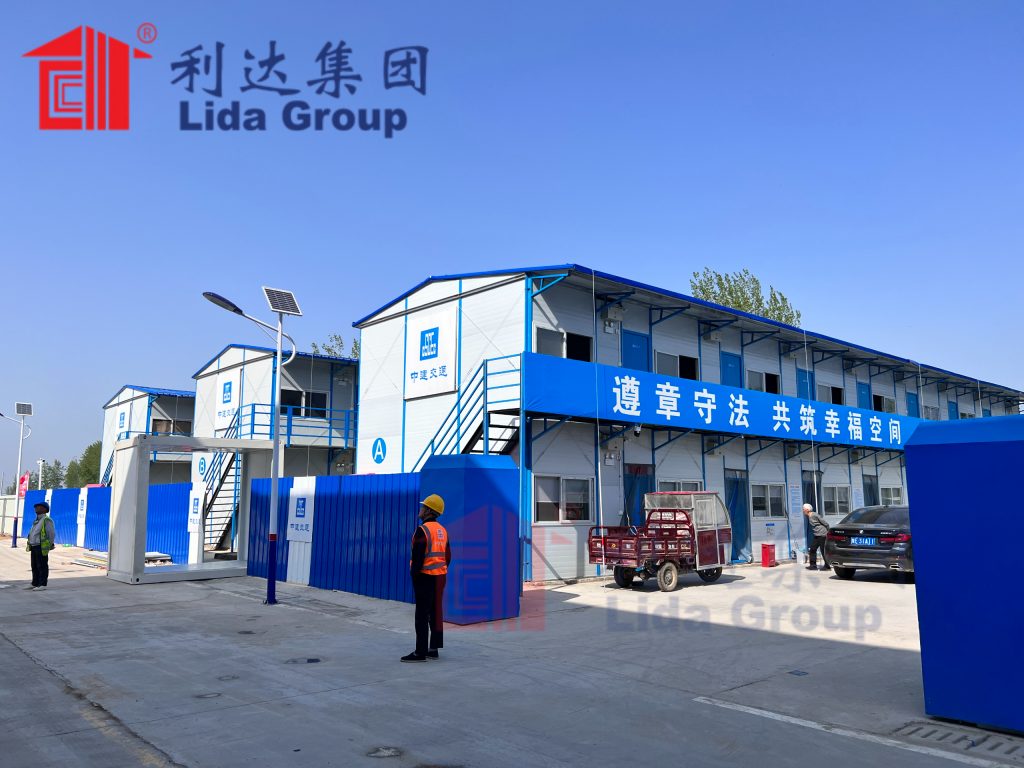
7. Market Impact and Competitive Advantage of Lida Group
7.1 Market Growth and Customer Reception
The global prefab mobile house market has been growing steadily in recent years, driven by factors such as increasing environmental awareness, the need for flexible housing solutions, and the growing affordable housing crisis. Lida Group, with its focus on eco-friendly, low-cost, and high-quality prefab mobile houses, has emerged as a key player in this market, capturing a significant share of the global market.
The company’s market growth can be attributed to several factors. First, its innovative use of sandwich panel walls has given it a unique selling point, distinguishing its products from those of competitors. The combination of eco-friendliness, low cost, and durability has resonated with customers across different sectors, from emergency housing organizations to eco-tourism resorts. Second, Lida Group’s global presence has allowed it to tap into markets around the world. The company has manufacturing facilities in Asia, Europe, and North America, enabling it to produce and deliver prefab mobile houses quickly to customers in different regions. It also has a strong distribution network, with local partners in many countries who help with sales, installation, and after-sales service.
Customer reception of Lida Group’s prefab mobile houses has been overwhelmingly positive. The company has received high ratings and positive reviews from customers, who praise the houses’ quality, comfort, affordability, and eco-friendly design. Many customers have highlighted the quick installation time as a major advantage, noting that the houses can be ready for use in a matter of weeks—far faster than traditional homes. The after-sales service provided by Lida Group has also been commended, with the company offering regular maintenance checks, repairs, and replacement parts to ensure that the houses remain in good condition for years.
In addition to customer feedback, Lida Group has received several industry awards and certifications for its prefab mobile houses. The company’s products have been certified by international organizations such as the International Organization for Standardization (ISO) for their quality and environmental performance. It has also won awards for innovation in sustainable construction, further cementing its reputation as a leader in the prefab mobile house market.
7.2 Competitive Advantage
Lida Group’s success in the prefab mobile house market is due in large part to its strong competitive advantage, which is built on several key pillars:
7.2.1 Innovation in Sandwich Panel Technology
Lida Group’s continued investment in research and development (R&D) has allowed it to stay at the forefront of sandwich panel technology. The company’s R&D team is constantly working to improve the performance, eco-friendliness, and cost-effectiveness of its sandwich panels. For example, in recent years, the team has developed a new type of sandwich panel with a recycled plastic core, further reducing the environmental impact of the panels while maintaining their strength and insulation properties. This focus on innovation has enabled Lida Group to offer products that are superior to those of competitors, giving it a technological edge in the market.
7.2.2 Vertical Integration
Lida Group operates a vertically integrated business model, controlling every stage of the prefab mobile house production process—from material sourcing and manufacturing to installation and after-sales service. This vertical integration gives the company greater control over quality, cost, and delivery times. By sourcing materials directly from suppliers and manufacturing components in its own factories, Lida Group can ensure that the materials used are of high quality and that the manufacturing process is efficient. It also allows the company to reduce costs by eliminating middlemen and streamlining the supply chain. Additionally, having in-house installation teams means that the company can ensure that the houses are installed correctly and efficiently, reducing the risk of delays or errors.
7.2.3 Strong Brand Reputation
Over the years, Lida Group has built a strong brand reputation for quality, sustainability, and reliability. The company’s commitment to using eco-friendly materials and manufacturing processes has made it a trusted name among customers who prioritize sustainability. Its track record of delivering high-quality prefab mobile houses for a range of applications—from emergency housing to eco-tourism—has also helped to build customer trust. A strong brand reputation not only attracts new customers but also helps to retain existing ones, as customers are more likely to choose a brand they know and trust.
7.2.4 Flexibility and Customization
Unlike many competitors who offer a limited range of standard prefab mobile houses, Lida Group prides itself on its flexibility and customization capabilities. The company’s modular design allows customers to tailor the houses to their specific needs, whether it’s a custom floor plan, a unique exterior finish, or specialized amenities. This flexibility has made Lida Group’s products appealing to a wide range of customers, from individuals seeking a personalized home to large companies with specific workforce housing requirements. The ability to customize also allows the company to adapt to changing market trends and customer preferences, ensuring that its products remain relevant in a dynamic market.
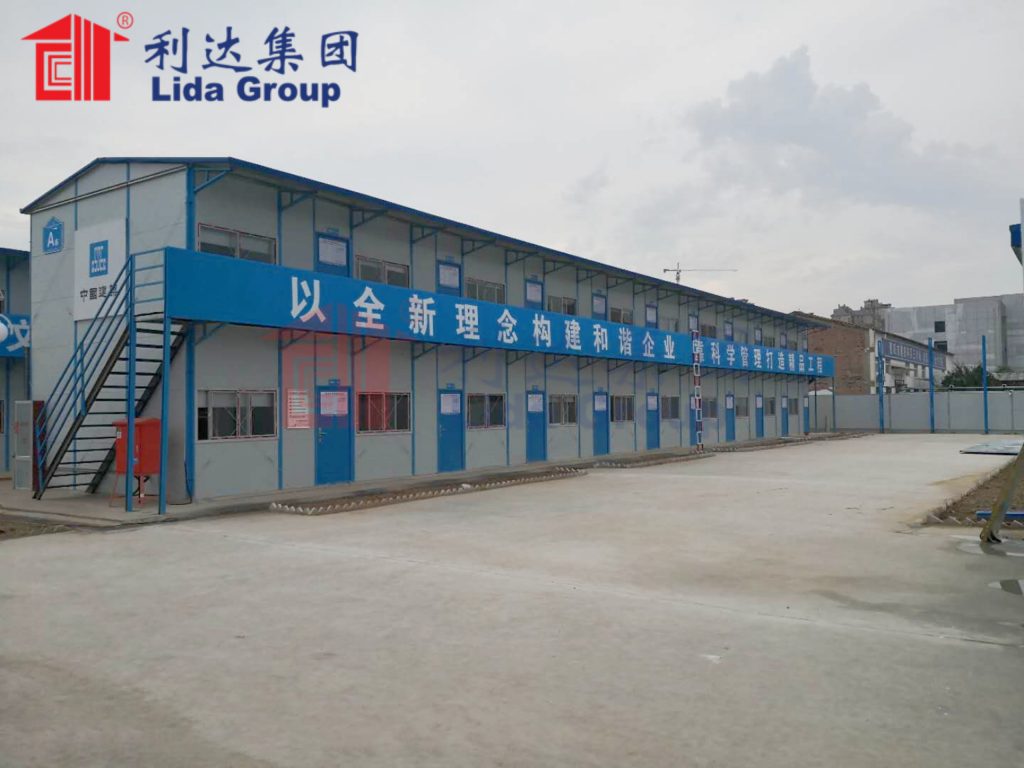
8. Conclusion
In a world facing pressing challenges such as climate change, resource scarcity, and the global affordable housing crisis, Lida Group’s prefab mobile houses represent a beacon of innovation and sustainability. At the core of these houses is the revolutionary sandwich panel wall system—an engineering marvel that combines eco-friendliness, low cost, durability, and comfort in a single component.
Throughout this article, we have explored the many facets of Lida Group’s prefab mobile houses. We began by understanding the context of the growing demand for sustainable, flexible housing solutions and the role that prefab mobile houses play in addressing this demand. We then delved into the science behind sandwich panel walls, examining their composition, manufacturing process, and the unique benefits they offer—from superior insulation and soundproofing to lightweight construction and easy installation.
We also explored the eco-friendly credentials of Lida Group’s sandwich panel walls, highlighting the use of recyclable materials, low-VOC adhesives, and environmentally friendly manufacturing processes that minimize energy consumption and waste. The low-cost advantage of these walls was another key focus, with we examining how Lida Group’s strategic material sourcing, efficient manufacturing, and easy installation translate into cost savings for both the company and the end user—from reduced initial construction costs to long-term energy and maintenance savings.
The design and functionality of Lida Group’s prefab mobile houses were also thoroughly discussed, emphasizing the high degree of customization available, the focus on comfort and livability, and the uncompromising commitment to durability and safety. We then looked at the wide range of applications of these houses, from emergency housing and temporary workforce accommodation to eco-tourism resorts and affordable housing projects—demonstrating their versatility and ability to meet diverse housing needs.
Finally, we analyzed the market impact of Lida Group’s prefab mobile houses and the competitive advantage that sets the company apart from its peers—including its innovation in sandwich panel technology, vertical integration, strong brand reputation, and flexibility in customization.
Lida Group’s prefab mobile houses are more than just a housing solution—they are a step towards a more sustainable, equitable, and flexible future. By prioritizing eco-friendliness and affordability without compromising on quality, the company has created a product that addresses some of the most pressing issues of our time. Whether it’s providing shelter to disaster victims, housing workers in remote areas, offering sustainable accommodation to eco-tourists, or giving low-income families access to safe, decent housing, Lida Group’s prefab mobile houses are making a tangible difference in the lives of people around the world.
As the global demand for sustainable, flexible housing continues to grow, Lida Group is well-positioned to lead the way. With its ongoing commitment to innovation, sustainability, and customer satisfaction, the company is poised to expand its market reach and make an even greater impact in the years to come. For individuals, communities, and organizations seeking a housing solution that is good for the planet, good for the wallet, and good for quality of life, Lida Group’s prefab mobile houses with eco-friendly, low-cost sandwich panel walls are the answer.

Related news
-
The Future of Labor Accommodation: Smart Technology Integration in Lida Group's Prefab Container Building Camps
2025-09-17 17:49:57
-
Lida Group Integrates Modern Amenities into Its High-Quality Container House Designs for Superior Worker Welfare
2025-09-17 17:32:44
-
Cost-Effective Workforce Housing: Lida Group's Prefab Container Building Approach Cuts Labor Camp Construction Timelines
2025-09-17 17:28:33
contact us
- Tel: +86-532-88966982
- Whatsapp: +86-13793209022
- E-mail: sales@lidajituan.com


